Hi guys,
Quite a bit of tuning data here so just bear with me. I'll try to provide the info as clearly as possible. But if anyone has any questions, feel free to ask and I'll do my best to answer.
As of right now, our Procede can control PWM Methanol injection, change AFR target and change ignition timing set points. All tunable "on-the-fly" mapswitching/tuning (ie, not requiring DME flashing/resetting or ignition cycling.) This gave us the ability to make incremental changes to the tune and see how the engine reacted on the dyno. Lot of dyno runs over the last two days (74 runs in all). Both with an essentially stock car (just Vanguard muffler section) and then again (the next day) with primary and secondary cat-deletes ($100 muffler shop special).
Test car is an early production 2008 E92 6MT with 60k miles on the clock. The only mod prior to testing is a Vanguard muffler section and big wheels (19" Linea Corsa rims with 295mm wide tires). All runs tested in 4th gear on a 3rd party Dynojet (DNR Racing in Hayward CA) in Power/M mode. Numbers are actual/uncorrected values (CR=1.00). Ambient temps for both dyno sessions were 75-86 deg F) with 34-45% Humidity. Fuel used was 91oct Unocal/76 which is the best quality fuel we can find at the pump here in CA.
Just an upgraded Vanguard muffler section. Still running stock X-pipe, cats, midpipe, etc,.:
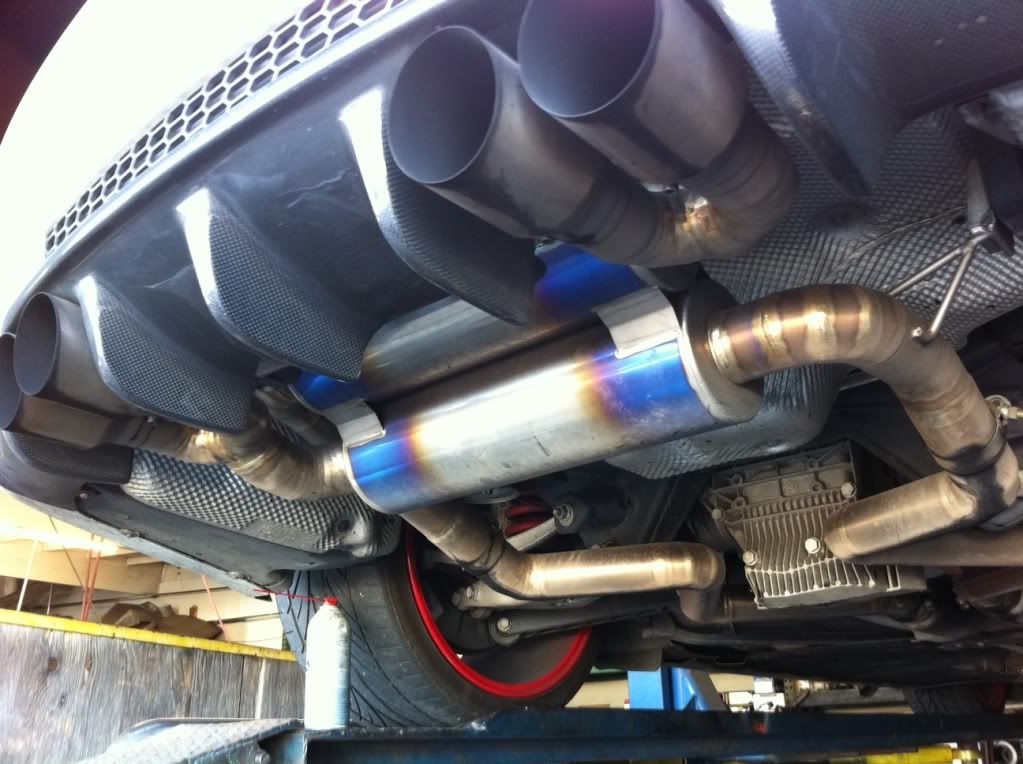 3rd Party Dynojet (DNR Performance in Hayward CA):
3rd Party Dynojet (DNR Performance in Hayward CA):
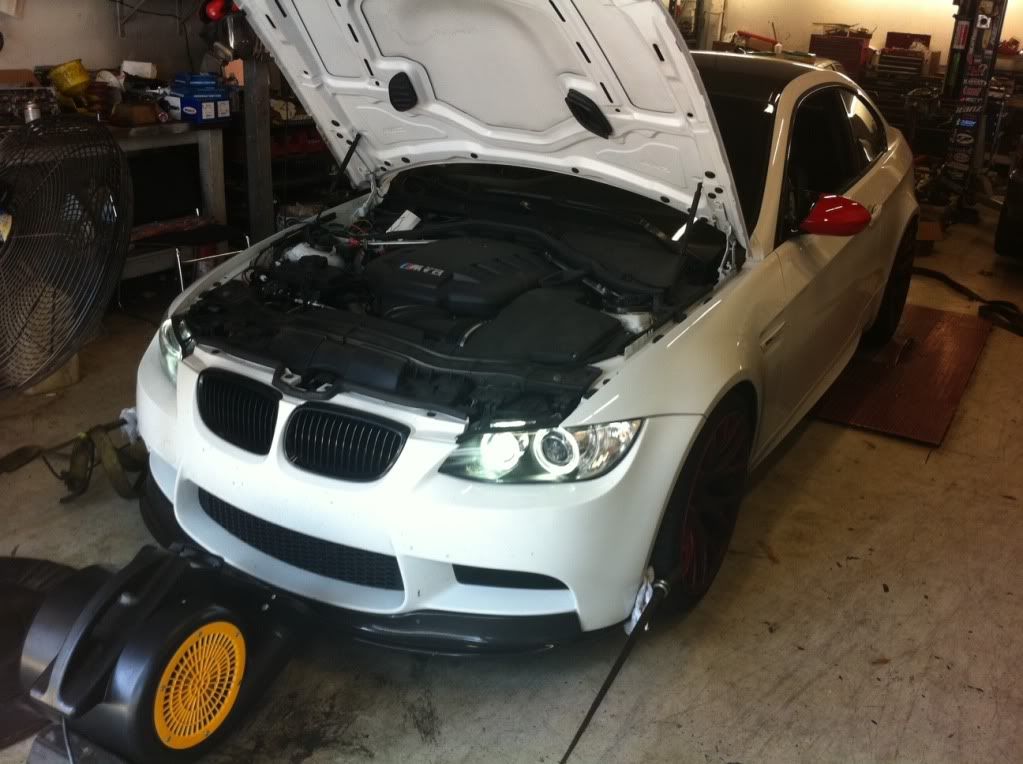 DAY ONE
DAY ONE
Yesterday, our goal was to establish a solid and repeatable baseline (we threw out the lowest outlines). And then to enable the Procede tune and PWM Meth system. At this time, all the Procede did was meter methanol spray and adjust ignition advance as a function of measured methanol flow. No changes were made to AFR targeting. In the end, we came up with these results:
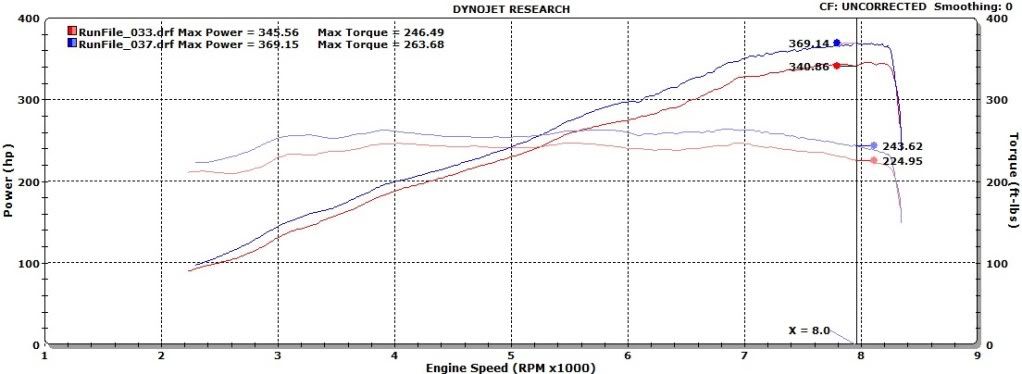 Analysis
Analysis
Properly metering methanol as a function of Throttle angle and Airflow was key to keeping the DME happy and code free. If methanol is injected like an on/off switch, the DME will trigger various fuel control codes. Caused by having to react to big AFR swings at meth spray onset. So by injecting progressively (via Aquamist PWM valve), the DME sees no such plausibility issues. The extra meth naturally provides a big cooling advantage, dropping measured inlet air temps (IATs) by approx 20 deg C (35 deg F)! Just spraying meth alone picked up approx 10whp at high RPM (not shown). But that is only part of the story. Methanol also increases octane much like running race fuel. This allowed us to run 4-6 degrees more ignition advance, getting us right to the point of maximum thermal efficiency or Min Advance for Best Torque (MBT for short). This is where every engine "wants" to run. However, real world constraints (temp and octane) usually prevent this. This is why a stock "420bhp" m3 doesn't really make 420whp on the road. It also explains why stock baseline dynos, from car-to-car/condition-to-condition/octane-to-octane can vary from 320whp to 350whp. Methanol allows us to "tune" the environment which, in turn, allows us to tune the engine the way it wants to be tuned for maximum. And do it
more safely than just trying to tune conventionally (ie, making the tune more aggressive without running meth or race gas, etc,.). So, at the end of the first day, running methanol and the extra ignition advance gave us not only big power gains, but also made the power perfectly consistent and 100% immune to heat soak. Which means that power gains in worse conditions will be every greater. But even in these temperate conditions, we saw gains of:
~30WHP at 8000RPM
~27LB-FT at 3000RPM
Note
When running the stock tune on pump gas, we found a natural variance of +/- 5whp. But, at times it got much worse. This seems to happen when cylinder head and iat temps get extra high.
It is also one of the runs we "threw out" as an outliner as it would lead to artificially inflated tuning gains. But it does clearly show how easy it is to get a low baseline if you dyno selectively:
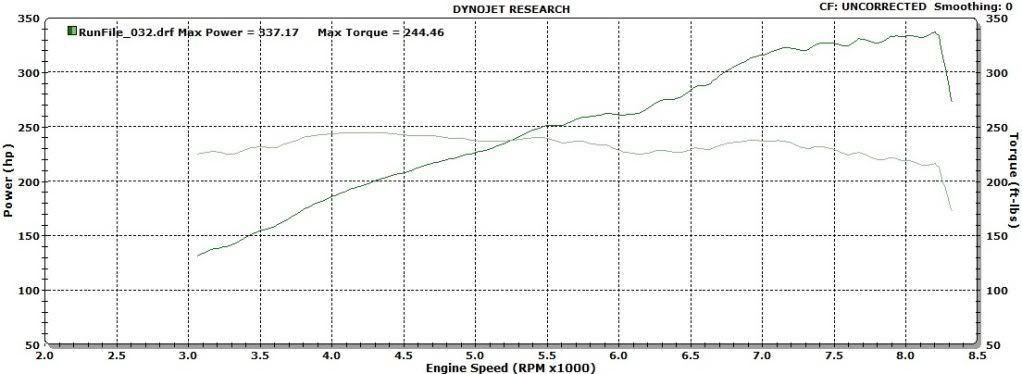 DAY TWO
DAY TWO
Today, we had two updates to the car and tune. First, we eliminated both primary and secondary cats. Stock X-pipe and resonators were retained. We used 2.5" crush bent aluminized steel piping that we fabricated at a local muffler shop. Nothing fancy. Cost us less than $100. I suspect using proper mandrel bends may be worth an extra hp or two.
We also got control of AFR targeting, giving the Procede to change factory AFR setpoints by +/- 3 points. This is a very wide adjustment range. AFR target changes are mapped via 3D table. RPM vs. Airflow (in kg/hour):
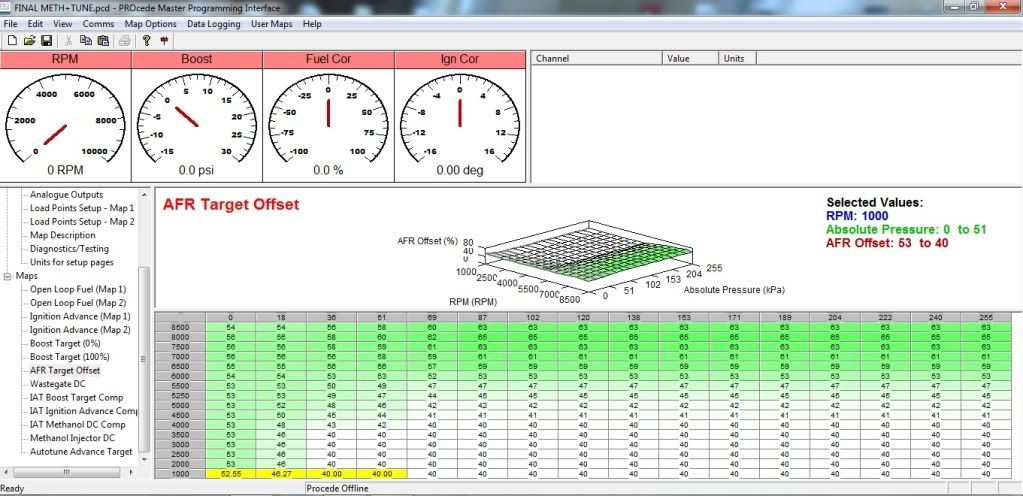
The first thing we did was quantify the gains we got from deleting both sets of cats while running the stock tune. Compared to yesterday's "no tune" baseline, todays "no-tune" baseline (with cat deletes) were good:
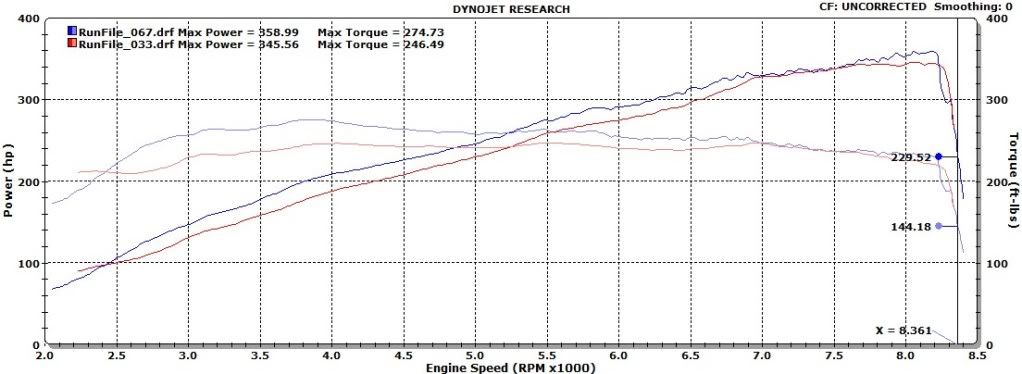
The next thing we did was to compare the stock tune (with the cat deletes) to various stages to Procede tuning. Without running methanol. It turns out that the reduction of exhaust back-pressure allowed us to be considerably more aggressive with the mapping.
First we simply enleaned AFR target (under heavy load) from 6500rpm and up. Basically increasing AFR from the mid 12:1s to high 12:1s. This is represented in the
Red run below (Run 68) This got us gains of 6-13WHP between 6700 and 8000rpm. Next, we added 2 degrees of advance across the board (under load). This gave an additional 6-11WHP from 5700rpm to 8400. This is the
Light Blue run below (Run 70). So through some admittedly pretty coarse tuning (and NO METH), we picked up a peak power gain of:
23WHP at 7500RPM
Stock tuning vs. Leaner up top vs. Leaner up top AND more ignition advance:
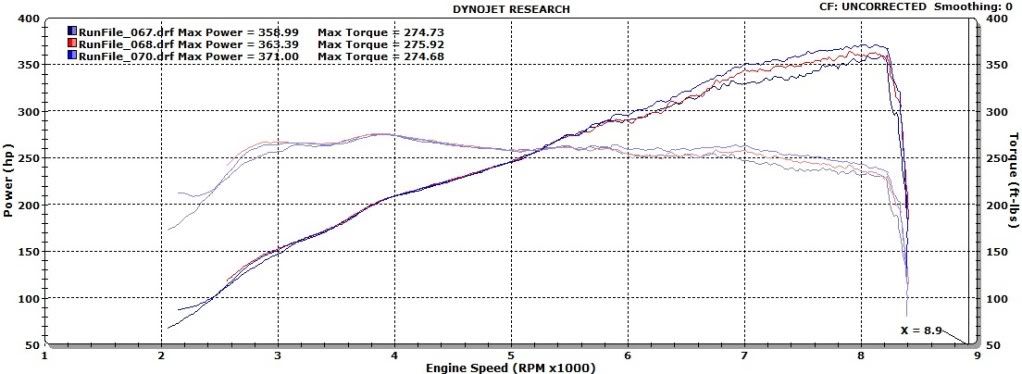
Finally, we enabled PWM methanol and spun up the dyno. Immediately, run to run variance dropped to within 1-2hp. Power curve smoothened out (less jagged). IATs dropped. The extra octane also allowed us to add a few degrees more ignition advance across the board. And after a few tuning runs, we saw this:
Procede tune vs. Procede Tune+Procede PWM Meth
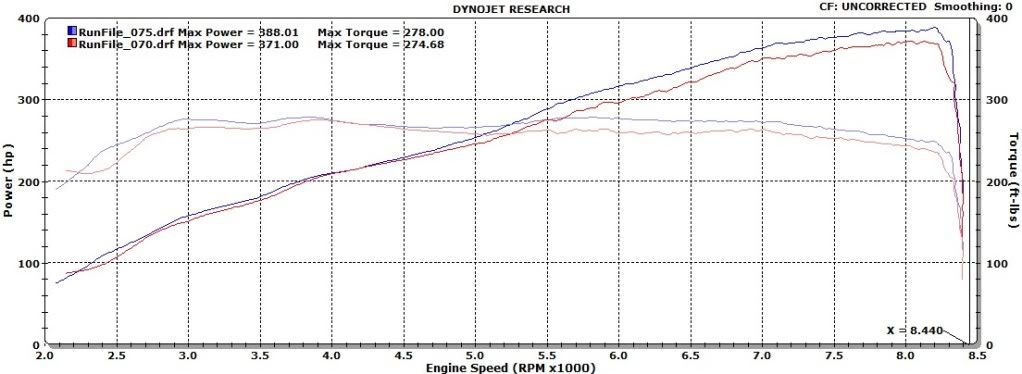
Gains of
20-25WHP from 5500 to Redline. We actually saw a
45WHP gain at a high 8300rpm but that's not that useful so we can ignore that for the sake of reasonableness
 SUMMARY
SUMMARY
It's been a fun couple weeks playing with this car. Compared to the n55/n54 engines that we've been tuning since 2007, the s65 does present it's share of challenges. Namely the granularity needed to squeeze out gains in an NA application. It definitely needs more fine tuning since we are dealing with relatively small incremental gains each step of the way. But the initial results are promising and they should only get better with time.
But as it stands now, by adding the following:
Vishnu Procede and PWM Meth kit ($TBA)
Muffler Shop Primary Secondary Cat Deletes ($100)
We saw the following REALISTIC gains:
Stock vs Vishnu Tuned (Procede+PWM Meth+Cat Deletes)
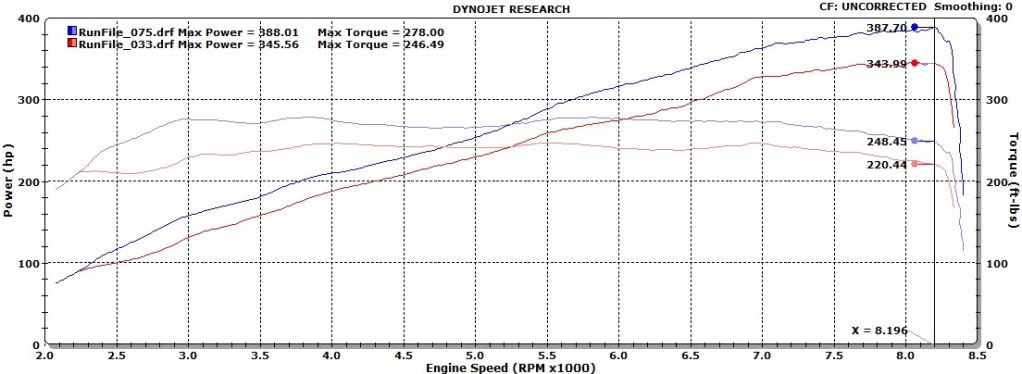
*
Gains of 20-45WHP over the ENTIRE useable power band.
*
53LB-FT peak gains at 2900RPM
*Absolute resistance to heat-soak
*Lower fuel consumption (leaner AFR targets and additional advance)
*Better part throttle response (due to lower IATs and extra advance)
*And niftly in-dash gauges, shift lights, code reading/clearing functions, misc DME activations, mapswitching, user tune-ability (if inclined.. but not necessary)
And if you are used to naughty tuner tricks (ie, comparing final tuned results to a HEATSOAKED baseline) you get the following results:
LOW stock baseline vs. Vishnu tuned
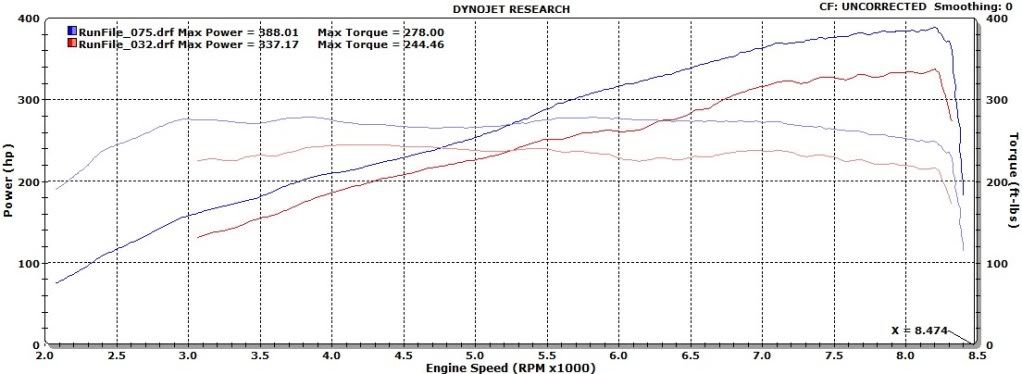
This will be the last time we ever show an unreasonably low baseline dyno result. This was done for entertainment purposes only

Please let me know if you guys have any questions.
Cheers,
Shiv
PS. BIG THANKS to Zoeb at Wheeldude.com for letting us use his car for testing
